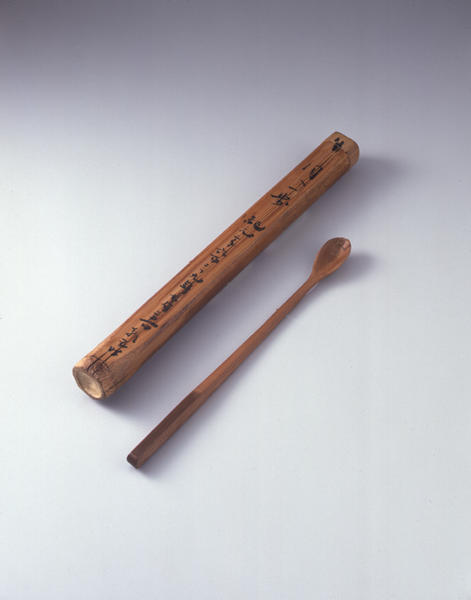茶杓 銘 月へ一歩(河瀬虎三郎作)
- 20c
- 木製(桧古材)
- D-20 W-1.6
解説(春の玉手箱)
河瀬虎三郎(一八八八~一九七〇)は、徳島県出身。刀剣の収集鑑定家として名を馳せたが、のちに茶の湯に活眼を開く。それは広く仏器、古陶磁などを自由に組み合わせ、また奈良に関連の深いもので取り合わせる“奈良茶”であった。
筒には「月へ一歩 紀元二千六百二十九年七月二十一日朝五時」「佐保山住人無窮亭 八十二」とあり、昭和四四年(一九六九)年七月二一日にアメリカのアポロ11号が月面着陸に成功したその日に削られたものであろう。人類が初めて月にその足跡を印したことへの記念のうちにも、表層的な古美術愛好ではなく、暮らしに根ざした融通無碍な河瀬の茶の面目を感じさせる。
Catalogue Entry
Kawase Iorasaburo (1888-1970) was born in Tokushima. Renowned as a collector and connoisseur of swords, Kawase later developed an interest in the tea ceremony. He was particularly interested in the free combination of Buddhist implements and old ceramics in his tea ceremonies, later focusing on “Nara tea," or events which brought together implements closely related somehow to Nara.
The bamboo container for this tea scoop is inscribed “Tsuki e ippo kigen nisen roppyaku nijukyu nen shichigatsu nijuichi nichi asa goji" This can be loosely translated as “A step on the moon, Kigen 2629 [1969] July 21st, 5 am" Thus this scoop was carved on the day that the American spaceship Apollo 11 safely landed on the moon, July 21, 1969. In this commemoration of the first human footprint on the Moon, we sense in Kawase not just a surface affection for antique art, but rather a broad‐ranging, uninhibited aesthetic rooted in daily life.
